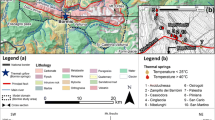Abstract.
In porous sediments of the Ishikari Lowland, there is a gradual increase in the background geothermal gradient from the Ishikari River (3–4 °C 100 m–1) to the southwest highland area (10 °C 100 m–1). However, the geothermal gradient at shallow depths differs in detail from the background distribution. In spite of convective heat-flow loss generally associated with groundwater flow, heat flow remains high (100 mW m–2) in the recharge area in the southwestern part of the Ishikari basin, which is part of an active geothermal field. In the northeastern part of the lowland, heat flow locally reaches 140 mW m–2, probably due to upward water flow from the deep geothermal field. Between the two areas the heat flow is much lower. To examine the role of hydraulic flow in the distortion of the isotherms in this area, thermal gradient vs. temperature analyses were made, and they helped to define the major components of the groundwater-flow system of the region. Two-dimensional simulation modeling aided in understanding not only the cause of horizontal heat-flow variations in this field but also the contrast between thermal properties of shallow and deep groundwater reservoirs.
Résumé.
Dans les sédiments poreux des basses terres d'Ishikari, on observe une augmentation graduelle du gradient géothermal général depuis la rivière Ishikari (3–4 °C 100 m–1) vers la zone élevée située au sud-ouest (10 °C 100 m–1). Toutefois, le gradient géothermal aux faibles profondeurs diffère dans le détail de la distribution générale. Malgré la perte de flux de chaleur par convection, généralement associée aux écoulements souterrains, le flux de chaleur reste élevé (100 mW m–2) dans la zone de recharge de la partie sud-ouest du bassin de l'Ishikari, qui appartient à un champ géothermal actif. Dans la partie nord-est des basses terres, le flux de chaleur atteint localement 140 mW m–2, probablement à cause d'un écoulement souterrain ascendant depuis le champ géothermal profond. Entre les deux zones, le flux de chaleur est beaucoup plus faible. Afin de déterminer le rôle du flux d'eau souterraine dans la distorsion des isothermes dans cette zone, des analyses du gradient thermal en fonction de la température ont été réalisées; elles ont permis de définir les composantes majeures du système aquifère régional. Une modélisation deux-dimensionnelle pour la simulation a ensuite contribué à la compréhension non seulement de la cause des variations horizontales du flux de chaleur dans cette région, mais également du contraste entre les propriétés des réservoirs superficiel et profond.
Resumen.
En los sedimentos porosos de las tierras bajas de Ishikari, hay un incremento gradual en el gradiente geotérmico desde el río Ishikari (3–4 °C 100 m–1) hacia la zona elevada del sudoeste (10 °C 100 m–1). Sin embargo, el gradiente geotérmico a profundidades someras difiere de la distribución de fondo. A pesar de las pérdidas por el flujo convectivo de calor asociadas generalmente al flujo de aguas subterráneas, el flujo de calor permanece elevado (100 mW m–2) en el área de recarga, hacia el sudoeste de la cuenca del Ishikari, la cual pertenece a un campo geotérmico activo. Al nordeste de las tierras bajas, el flujo de calor alcanza 140 mW m–2, probablemente por el flujo ascendente de agua procedente del campo geotérmico profundo. Entre ambas áreas, el flujo de calor es mucho menor. Para examinar el papel del flujo hidráulico en la distorsión de las isotermas de esta región, se ha comparado el gradiente térmico con la temperatura, con lo cual se ha podido definir los componentes mayoritarios del sistema de flujo de las aguas subterráneas. El uso de modelos bidimensionales ha servido para comprender no sólo del origen de las variaciones horizontales del flujo de calor en este campo, sino también el contraste entre las propiedades térmicas de los reservorios someros y profundos de aguas subterráneas.
Similar content being viewed by others
Author information
Authors and Affiliations
Additional information
Electronic Publication
Rights and permissions
About this article
Cite this article
Dim, .J., Sakura, .Y., Fukami, .H. et al. Spatial characteristics of groundwater temperature in the Ishikari Lowland, Hokkaido, northern Japan: analytical and numerical applications. Hydrogeology Journal 10, 296–306 (2002). https://doi.org/10.1007/s10040-002-0190-z
Received:
Accepted:
Issue Date:
DOI: https://doi.org/10.1007/s10040-002-0190-z




